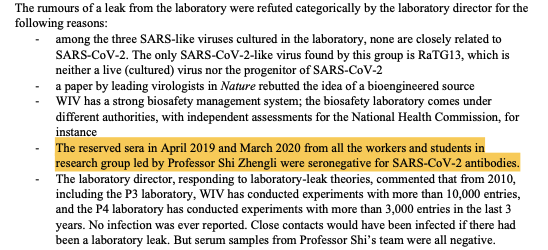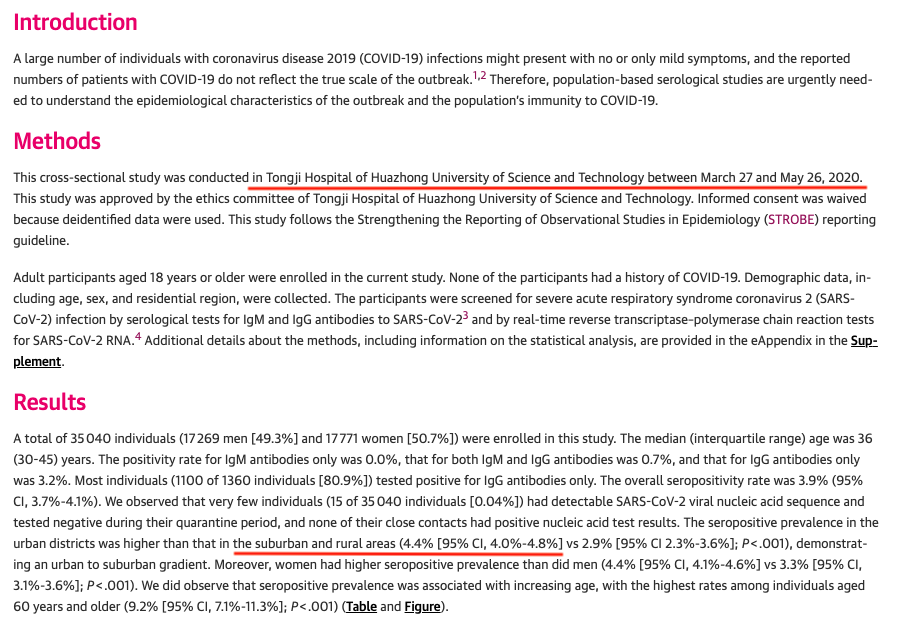White Unicorns - or the silly stories about no Covid-19 positive tests at the WIV (and other labs)
Issue #1:
Sorry @China__Focus, but you have been caught lying.
Ignoring your 2019 typo (should be 2020), the 700 tests ILI samples are from the Wuhan Xiehe Hospital - not from the WIV (which anyway has 590 staff and students).
From Annex D7 of the China-WHO study report: 
Issue #2:
The WIV did test some lab staff in April 2019 and March 2020.
Given that the prevalent IgG+ rate in Wuhan was about 4.4% at the time then there would have been positive tests. 
First let's be clear that the prevalent IgG+ rate was around 4.4% in urban Wuhan around April 2020 (95% confidence interval: 4.0%-4.8%).
See jamanetwork.com/journals/jaman… 
Then let me show you the probability of 0 IgG+ (positive test for pas Covid-19 infection) amongst 550 staff and students at the WIV (I cut it a bit from 590): 
Let's try again with the lower value of the confident interval: 4%, and let's say that the WIV was a bit lazy and tested only 100 students and staff (which makes the test quite irrelevant actually):
1.7% is one chance in 60. 
Said otherwise people at the WIV MUST have tested positive for Covid-19 antibodies (IgG) in March 2020.
Either a ridiculously small group of people was tested (17 people gives 50/50 chance of 0 positive with a 4% background rate) or the whole story is just lies. 
To make it worse, the WIV should have actually tested all 590 staff and students, plus construction workers.
That was not the first time funny statements were made about no positive antibodies test at labs in Wuhan. Let's go through previous examples:
Shi Zhengli’s Reply to Science Magazine, pdf dated 27th 2020:
Q: Is it possible that someone associated with the institute became infected in some other way, for instance while collecting, sampling, or handling bats?
A: Such a possibility did not exist. Recently we tested the sera from all staff and students in the lab and nobody is infected by either bat SARSr-CoV or SARS-CoV-2. To date, there is "zero infection" of all staff and students in our institute.
Peter Embarek quoted in Science Magazine 14 Feb 21:
Q: But my question is whether you learned anything new in China. Now that you’ve been there, do you have more reason to say it’s “extremely unlikely” than before?
A: Yes. We had long meetings with the staff of the Wuhan Institute of Virology and three other laboratories in Wuhan. They talked about these claims openly. We discussed: [--] ‘Did you test your staff? [--]. They had retrospectively tested serum from their staff. They tested samples from early 2019 and from 2020.’
And then these so statements of no positive cases were used in the China-WHO report to dismiss any possiblility opf a lab-related accident:
Arguments against
[---]The three laboratories in Wuhan working with either CoVs diagnostics and/or CoVs isolation and vaccine development all had high quality biosafety level (BSL3 or 4) facilities that were well-managed, with a staff health monitoring programme with no reporting of COVID-19 compatible respiratory illness during the weeks/months prior to December 2019, and no serological evidence of infection in workers through SARS-CoV-2-specific serology-screening.
Maybe you would ask if one could argue that the WIV people were somehow isolated from the general population in the "safety" of their lab?
Unfortunately no. A few lab researchers may have isolated untill Wuhan got into a lockdown on the 23rd Jan. But that would be a small fraction of the population of interest, which is all staff including maintenance plus students.
The ones who may have self isolated at the WIV and other labs of interest would have been the ones studying SARS-CoV-2 and doing corresponding sample testing.
But that would be a small fraction of the population of interest, which is all staff including maintenance plus students. Most of these most likely never self isolated before the Wuhan lockdown and are representative of that Wuhan urban population with a demonstrated 4.4% seropositivity in April 20 (95% Confidence Interval: 4.0%-4.8%).
Mathematical corner:
Here is how you can easily tabulate the probabilities in your head:The key is to remember that with a 4% seropositivity rate there is very close to a 50% chance of no seropositive in a group of 17 people.
This is a simple binomial distribution result. See for instance this online calculator.
If you add another 17 people, the probability of no seropositive in the group is again divided by 2. From there you can see that the probability of no seropositive at in a group of (n * 17) people is ~1/2^n.
510 is still short of the 590 staff and students at the WIV.
510 = 30 x 17 = 3 x 10 x 17. But 1/2^10 ~ 1/1,000, so the probability of no seropositive in a group of 510 people is around 1/1,000^3 = 1 in a billion!
If you prefer to work in powers of 1/100 then the probability is about 0.01 for a group of 113 people. So for 565 people (5 x 113) it becomes 1/10^10, a 10th of a billionth!
Issue #3:
Now going back to that paper jamanetwork.com/journals/jaman…, it’s interesting to see that ‘Informed consent was waived because de-identified data were used.’
Basically no need to ask people for consent as data is anonymised. 
But for some reason the joint-team mission could not have access to raw data due to the very strict privacy laws in China.
Not sure how that works - since you can apply for a waver with anonymised data, as was done for that paper.
I call that a lie.
prospectsconsultation.co.uk/who-coronaviru… 
Maybe that explains why @DrTedros lost patience with all the nonsense and foot dragging from the Chinese authorities.
#DRASTIC